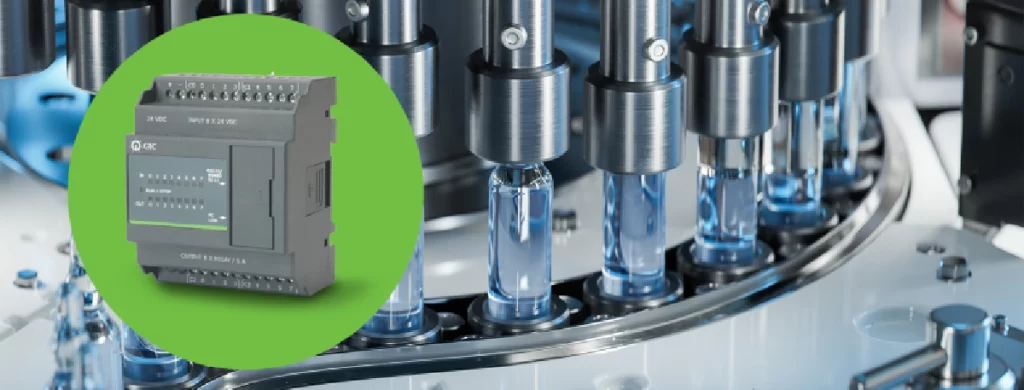Table of Contents
TogglePLC - Programmable Logic Controller : Introduction
A Programmable Logic Controller (PLC) is a special type of computer used in industries to control machines and processes in automation sector. It takes signals from sensors (inputs), makes decisions based on a program, and sends signals to machines (outputs) to control them.
PLCs come in different sizes. Some are small enough to hold in your hand, while others are big and need a special cabinet. Some have only basic input and output options, but you can add more parts like extra I/Os, communication ports, or screens to match different industrial needs.

How Does a PLC Work?
A PLC (Programmable Logic Controller) is like an industrial computer, but it doesn’t have a mouse, keyboard, or screen.
The program to control machines or processes is created on a normal computer. Once the program is ready, it is sent to the PLC using a cable. The PLC stores this program in its memory.
This program is written using special languages like Ladder Logic, Statement List, or Function Block Diagram. These are designed to be easy for people with an electrical or instrumentation background to understand.
The PLC has input terminals and output terminals. It reads signals from switches and sensors through the input terminals. Based on those signals and the program, it controls devices like motors, valves, or lights using the output terminals.

What Are the Main Types of PLCs?
There are two main types of PLCs: Fixed and Modular.
- A Fixed PLC has a set number of input and output points. You can’t add more. These are simple, low-cost, and good for small machines.
- A Modular PLC lets you add or remove parts like input/output modules, communication modules, etc. These are more flexible and used for bigger, more complex systems.
Each type has its own advantages: Fixed PLCs are compact & affordable whereas modular PLCs are expandable & customizable.
Fixed PLCs
Fixed PLCs are small, low-cost & commonly used. They are great for simple or portable machines that do one job. All the parts—like the processor, inputs, and outputs are built into one unit. But they can not be expanded or upgraded, and if something goes wrong, they are harder to repair. You may need to replace the whole unit, which can lead to downtime.
Modular PLCs
Modular PLCs are larger, more flexible, and easier to fix. You can add more input/output (IO) modules, upgrade memory, or replace parts easily. They are great for big or complex systems. If one module fails, the rest can still work, which reduces downtime. Modular PLCs are more expensive but ideal for growing or advanced automation systems.
Basic architecture
The below figure indicates the basic architecture. Below are the important components of the system:
- Central Processing Unit
- Processor
- Memory
- Power Supply
- Input/Output Module (IO Module)
- Communication Protocol
- Programming Device

Benefits of Programmable Logic Controller
Before PLCs were invented in the late 1960s, industries used hard-wired relay systems to control machines. But those systems were slow to change and hard to maintain.
PLCs brought major improvements:
Easy to Update
With relays, changing a system meant rewiring everything. With PLCs, you just update the program. It saves a lot of time and effort.More Reliable
Programmable Logic Controllers do not have moving parts like relays, so they last longer and are less likely to break. They also work well in tough conditions like heat, dust, and vibration.Better Control & Monitoring
PLCs can handle complex tasks, manage many signals at once, and give real-time feedback. This makes machines run more smoothly and efficiently.
5 Standard PLC Programming Languages
There are five main types of programming languages used:
Ladder Logic – Most commonly used; looks like electrical wiring diagrams.
Function Block Diagram (FBD) – Uses blocks to show functions and signals.
Sequential Function Chart (SFC) – Shows steps and transitions like a flowchart.
Structured Text (ST) – Uses text-based commands, like computer coding.
Instruction List (IL) – A simple list of instructions (now less commonly used).
All these languages can do the same job. The choice depends on the user’s comfort and the application.
How PLCs Work with SCADA and HMI Systems
SCADA and HMI systems help users see and control what’s happening on the factory floor.
Programmable Logic Controller are a key part of these systems. They connect the actual machines (like motors, sensors, or conveyors) to the SCADA or HMI screen.
PLCs collect data from the machines, send it to the SCADA/HMI, and also carry out control commands like turning devices on or off. This helps run and monitor things like temperature, robots, and production lines automatically and smoothly.
Interested in Learning PLC under 1 Hour?
I hope you like above blog. There is no cost associated in sharing the article in your social media. Thanks for reading!! Happy Learning!!



1 Comment